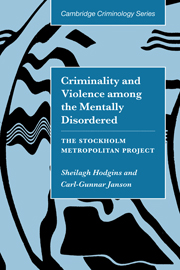Book contents
- Frontmatter
- Contents
- List of figures
- List of tables
- Preface
- Introduction
- Chapter 1 Research on the criminality and violence of the mentally ill
- Chapter 2 The longitudinal approach
- Chapter 3 Swedish society and Stockholm: the cohort and its context
- Chapter 4 Criminality
- Chapter 5 Explanations of the criminality of the mentally ill
- Chapter 6 Early and late-starters
- Chapter 7 Conclusion
- References
- Index
- References
References
Published online by Cambridge University Press: 22 September 2009
- Frontmatter
- Contents
- List of figures
- List of tables
- Preface
- Introduction
- Chapter 1 Research on the criminality and violence of the mentally ill
- Chapter 2 The longitudinal approach
- Chapter 3 Swedish society and Stockholm: the cohort and its context
- Chapter 4 Criminality
- Chapter 5 Explanations of the criminality of the mentally ill
- Chapter 6 Early and late-starters
- Chapter 7 Conclusion
- References
- Index
- References
- Type
- Chapter
- Information
- Criminality and Violence among the Mentally DisorderedThe Stockholm Metropolitan Project, pp. 199 - 221Publisher: Cambridge University PressPrint publication year: 2002

